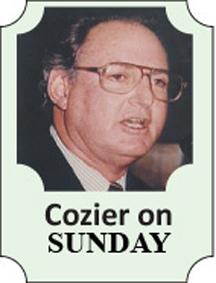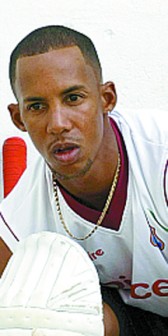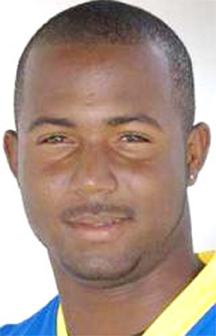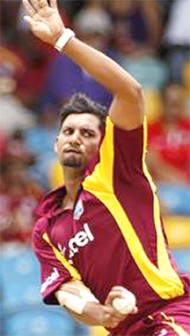As they gathered in Barbados on Friday for two weeks of what the West Indies Cricket Board (WICB) described as “fitness testing”, Ottis Gibson and his new assistant, Toby Radford (presumably an official explanation for David Williams’ replacement is to follow), had to go beyond such a narrow remit and, as well, concentrate their players’ minds on the imminent task of confronting the powerful Australians.
Such preparation would have been compromised by two familiar issues – the recurring off-field distractions that are potentially more disruptive than ever and the loss of key players through injury or illness (not counting Chris Gayle, through mutual intransigence).
The Gayle affair, in which Gibson himself is a central figure, continues to consume more attention than any other subject with no indication of whether the imposing left-hander will return to West Indies colours and, if he does, when.
It is almost a year since the WICB gave him the ultimatum that he would not be considered for selection unless he withdrew his radio interview censure of Gibson, WICB chief executive Ernest Hilaire and the board itself. Neither side has budged, the board restating its position and Gayle sticking to his stand that he has nothing to apologise for.
 Efforts to reach an agreement, extending beyond the WICB and Gayle to third, fourth and fifth parties, have gone on unsuccessfully for several months now.
Efforts to reach an agreement, extending beyond the WICB and Gayle to third, fourth and fifth parties, have gone on unsuccessfully for several months now.
In the interim, inexperienced youngsters. like Adrian Barath, Kraigg Brathwaite and Kieron Powell, charged with the daunting mission of somehow trying to fill Gayle’s opening spot, find themselves in doubt over their immediate future. It’s all the more reason for the Jamaica Cricket Association (JCA) to succeed in the latest attempt at mediation it has scheduled later this month.
While this conflict has dragged on, Guyana’s players are now caught in the middle of the political fight that led to the government’s disbandment of the Guyana Cricket Board (GCB) and its creation of an Interim Management Committee (IMC) in its place. The WICB predictably backed the GCB, one of its long-standing shareholders.

As it has become more acrimonious by the day, with police searches of the homes of GCB directors, the courts increasingly occupied with injunctions and affidavits and the newspapers filled with charge and counter-charge from the two sides, there is now doubt over whether a Guyana team picked by the IMC will be allowed to complete the current regional four-day tournament.
They, and other contentious squabbles, mainly between the WICB and the West Indies Players Association (WIPA), can only serve to distract players whose focus should be strictly on their on-field opponents.
As if such irresponsible conduct by those in positions to lead is not enough to undermine the focus of team camps, such as that now in progress, the no-show of the West Indies’ two leading ODI players of last year is another serious blow.
Lendl Simmons cracked a finger in Trinidad & Tobago’s match against Barbados two weeks back. The prognosis then was that it would take four to six weeks to mend. At best, that would carry him up to the first ODI against Australia, at Arnos Vale in St. Vincent, on March 16; it is more likely that he would have to miss all five ODIs.

A shoulder injury kept Ravi Rampaul out of Trinidad & Tobago’s first two matches of the first-class season and since then he has been stricken with dengue fever, hence his absence from the “fitness testing”. It is a debilitating illness from which Rampaul, a fast bowler, is unlikely to sufficiently recover in time for the Aussie ODIs.
Replacements, especially for Simmons as opener, are not readily identifiable. If there are several other bowling alternatives, and Arnos Vale and Beausejour’s in St. Lucia (venue for the last two ODIS), have the reputation of unfriendliness to pacers, Rampaul was in the best form of his life last year, in the varied conditions of the Caribbean, in India and in Bangladesh.
While Simmons, now into fifth year of international cricket, still hasn’t cracked Test cricket (he averages 17.37 from eight matches), he has been far more comfortable in the shorter format where his shot-making has a freer rein. In 17 ODIs in 2011, he averaged 49.5 at a strike rate of 79.75 runs per 100 balls and scored his first hundred for West Indies, 122 against Bangladesh.

Added to his batting, his sharp fielding, his useful medium-paced wobblers in a pinch and his ability to keep wicket make him the ideal limited-overs cricketer. If he is unavailable, the selectors would be seeking such variety.
The name that springs to mind as an unconventional choice in the circumstances is Dwayne Smith, a player with Simmons’ aggressive approach to batting who recently opened for Barbados in the Caribbean T20 and went in No.4 in the Bangladesh Premier League (BPL), a fleet-footed fielder and a capable medium-pacer. But selectors tend to be more conservative than that.
Rampaul’s 2011 figures are as impressive as Simmons, in his case in both Test and ODI versions. Dropped after the 2010 home series against South Africa, he made a sensational return in the World Cup, instantly silencing 50,000 Indians by dismissing Sachin Tendulkar with his sixth ball in his first match, finishing with five for 51 from his 10 overs.
It was just the kickstart for the self-belief he previously seemed to lack. In his 15 ODIs for the year, he took 28 wickets at 21.49 and an economy rate of 4.98 (along with 31 wickets in eight Tests at 25 runs apiece).
There is a host of fast and medium bowlers at Cave Hill from whom the selectors can chose (Kemar Roach, Andre Russell, Darren Sammy, Shannon Gabriel, Nelon Pascal and the returning Dwayne Bravo and Tino Best). Any would be pleased to match Rampaul’s 2011 return.
Such setbacks are somewhat moderated by the homecoming of Dwayne Bravo from his T20 exploits across the globe.
An ebullient all-rounder who has clearly refound his groove (he opted out of the team last June stating he wasn’t happy with his game and needed time to “rest, refocus and reflect”) his enthusiasm has been infectious ever since he came into international cricket in 2004.
Now, if he could sort out all the off-field nonsense as well, he would instantly take over as board president and team captain. But no one has yet found the formula for cricketing peace for 20 years and counting.





